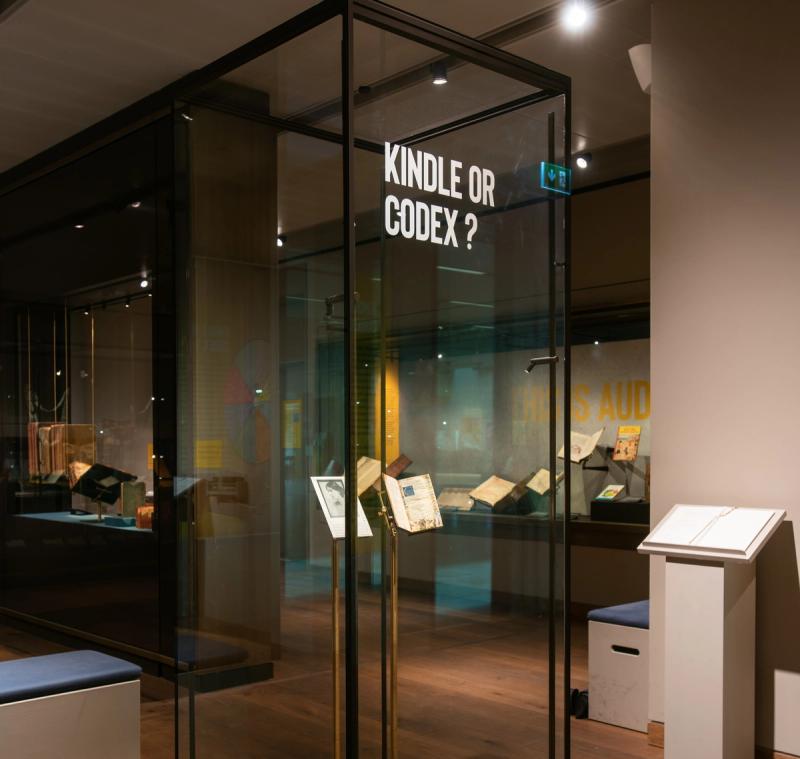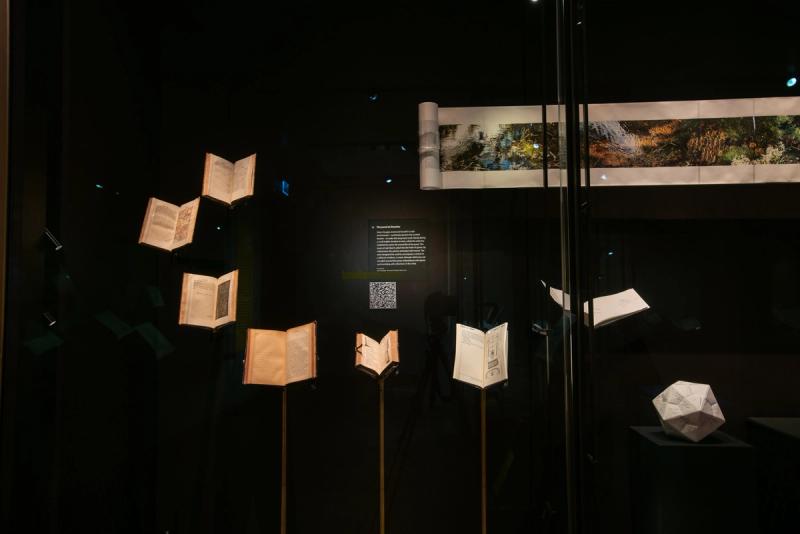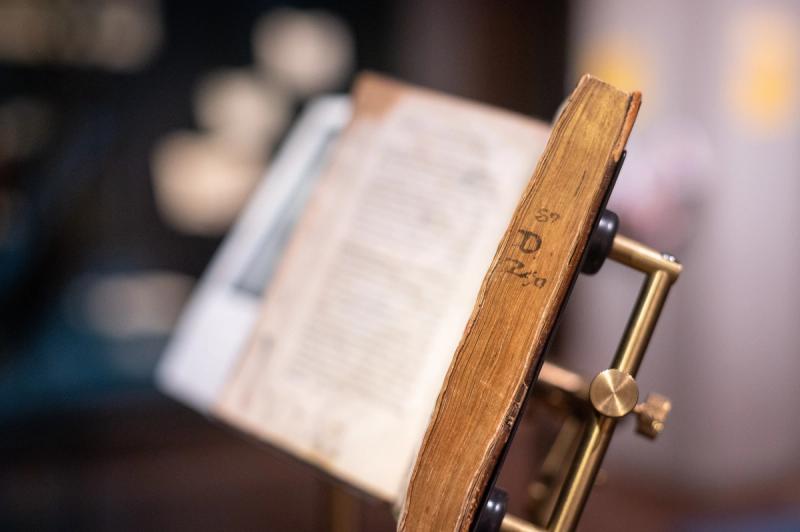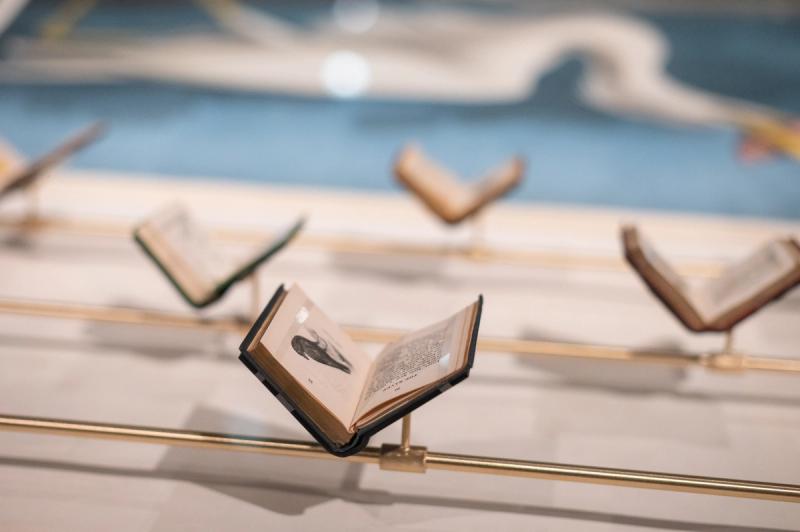
An Exhibition at Oxford Highlights the Sensorial Splendor of Books
In 1940, Dorothy Kunhardt published a book that would forever change the way young children read. Pat the Bunny, an interactive book full of activities such as touching the sandpaper of “Daddy’s scratchy face,” playing peekaboo with a piece of cloth, or gazing in a mirror, imbued the act of reading with a new form of sensory engagement. Today, “touch and feel” books for babies and children are almost required reading—their cellophane stuffing produces a satisfying, A.S.M.R.-level crunching sound, while the use of faux rabbit fur or horse hair offers an exhilarating tactile experience. As we age and our reading comprehension sharpens, the books we pick up prioritize a single sense—sight—their stories seemingly locked away in lines of text.
An exhibition at the Bodleian Libraries at the University of Oxford, titled “Sensational Books” (on view through December 4), delves into the many roles that books play in our lives across the senses. Co-curated by Kathryn Rudy, professor of art history at the University of St. Andrews, and Emma Smith, professor of Shakespeare studies at the University of Oxford, the exhibition opened to the public in May after two years of delays due to the pandemic. Celebrating the physical book in all its exquisite and unusual forms, “Sensational Books” draws from the centuries-old library’s illustrious collections to understand more deeply what books can tell us beyond the words and images they contain.

As visitors enter the gallery in the Bodleian’s Weston Library, they are greeted with a vitrine asking “Kindle or Codex?” that acknowledges the shifting role of books in our lives due to the increasing presence of digital and audio reading. Though these more recent advents are more efficient for delivering content, their streamlined simplicity dissolves a world of sensory inputs once associated with reading. “There’s the weight of the book, the sense of the paper, the feel of the cover, the smell of it, the sound it makes when pages turn,” Smith says. “We tried to start with that, to remind people that they are conscious of using different senses when they read books.”
One interactive exhibit invites visitors to encounter famed literary objects and refine their olfactory palate through a collection of perfume atomizers containing scents distilled from books including Shakespeare’s 1623 First Folio and one of the Bodleian’s greatest treasures: a 1217 copy of Magna Carta. A scent distilled from a collection of 17th- and 18th-century books, usually housed on the timber shelves of the Bodleian’s oldest reading room offers a warm, sweet aroma characterized by meadow hay, pipe tobacco, and cedarwood. The prized Magna Carta, by contrast, boasts “an aromatic mix of moist wheat bread and beach sand,” Smith says.
The smokey, spicy aroma extracted from an Ethiopian gospel bound in kid leather demonstrates a book’s rare ability to absorb and retain the scents of its surrounding environment for decades. Smith reflects upon a project when, years earlier, the Bodleian worked with members of local Ethiopian and Eritrean communities to co-curate a selection of manuscripts and icons produced in the Ge’ez language. In the process of reviewing materials for the display, a group of co-curators of Eritrean descent opened the kid-bound gospel and concurred that the scent contained within its pages had the aroma of “home.”
The scents from these celebrated works on paper were developed in collaboration with the Oxford-based Institute for Digital Archaeology (IDA), a venture that promotes the development and use of digital imaging techniques in conservation. Using noninvasive techniques specially developed by the IDA, technicians placed objects in sealed glass containers and used circulated air to capture the compounds that carry each book’s scent. Olfactory specialists then bottled the scents to be experienced alongside one another, with the aid of an informative wheel chart of aromatic notes created in the spirit of those used for cheese or wine tasting. “It is indeed a bit like wine tasting,” Smith says. “Once you’ve got the vocabulary, you can begin to differentiate the smells.”
Through a series of objects that employ books as an artistic medium, “Sensational Books” also investigates the relationship between bound pages and our taste buds. In her piece “Farmer’s Market” (2019), artist Dizzy Pragnell examines the materiality of books’ early antecedents, centering upon the layering of natural papyrus fiber, a technique used in ancient Egypt and other Mediterranean cultures to create writing materials before the introduction of paper. Pragnell’s technique reimagines this history in the form of five books whose pages are composed of thinly sliced dried fruit and vegetables—materials that tempt the viewer’s appetite and satisfy the senses through exquisite color and pattern.
Another particularly magnetic piece on display comes from New York–based artist, designer, and publisher Ben Denzer. No stranger to the book as an art form—his credits include designing book covers for Penguin Art Group and running the Instagram account @ice_cream_books, which counts both Bella Hadid and art critic Hal Foster among its fans—Denzer is behind 20 Slices (2018), a hard cover book whose pages are substituted by shelf-stable, plastic-wrapped slices of American cheese. The book rotates slowly—perhaps infinitely, one might wonder—in a mini fridge, its pages an imperishable material offering a point of inquiry about art books and preservation.
Several works in the exhibition examine the sense of touch in connection with reading, using books that have collided with hands... and lips. A German 16th-century missal printed partly on silk includes in its pages a pasted-in “osculation plaque” for a priest to physically kiss the book in an act of religious devotion. Another ecclesiastical artifact, designed as an aid for repentant 17th-century sinners, is “Nouvelle invention d’une excellente methode, pour ... une bonne confession.” Composed of hundreds of perforated tabs, each bearing a different transgression, this “catalog of immorality” permitted users to conveniently tear out a prewritten confession and present it to their priest rather than speak the words themselves.
John James Audubon’s colossal illustrated The Birds of America (1827–38) demonstrates the sense of proprioception—the body’s ability to sense movement, action, and location, often described as the “sixth sense.” The brown leather-bound book is just under a meter and half in length, or about the wingspan of a large seagull, as the audio guide appropriately notes, and requires two people to open it and turn its blanket-like pages. “We’re focusing attention on the physical work we’re always doing with books,” Smith says. “It’s how hard we need to hold them open, how tight the binding is. It explores how books are bits of paper and engineering.” Contrasted with a group of smaller volumes, one can begin to imagine the incongruity in the physical experience of handling and reading each one.
As visitors approach the section on sound and hearing, they are greeted by an impressive 14th-century book of psalms from the Church of St. Lawrence in Trau, its pages rippled and warped by the moisture exhaled by singing chorus members of centuries past. Andy Warhol’s Index (1967), a tongue-in-cheek “children’s book for hipsters,” serves as a multi-sensory encounter personified by a pop-up castle, a sheet of LSD stamps, and a 45-rpm flexi-disc that plays a previously unrecorded song by Nico and the Velvet Underground.
Further sonic studies in the exhibition include a series of sound-based works by artists Helen Frosi, Pale Blue Dot Collective’s Louise Beer and John Hooper, and Amy Sterly and Andrew Albin. Pale Blue Dot Collective’s “Audioscripts,” a piece co-commissioned for the exhibition with Fusion Arts in Oxford, looks at the auditory output of our physical interactions with books. Recordings include the sound of pages turning, books being arranged on shelves, and hands moving across textured covers against a backdrop of sounds documented from nature in three audio compositions. “We wanted a lot of noise in the exhibition room—some of which was specifically of books, and some which was creatively spinning off of that,” Smith says.
“Sensational Books” also explores sound as a means to enrich and provide access to the art-viewing experience. Exhibition curators partnered with VocalEyes, whose mission is to foster opportunities for blind and visually impaired people to enjoy art and heritage, to create an audio described highlights tour. The guide—which was developed with all viewers in mind—connects visitors intimately with the objects on display using lush descriptions of how each book may look, sound, feel, and smell.
One idea that began to materialize in the early stages of producing the exhibition is the reciprocal nature of reading physical books. As books shape our thoughts and experiences, we, too, imbue them with traces of ourselves, from handwritten annotations to smudges that show signs of frequent use. In this way, the story of the material books is a story of human nature—our activities, our relationships, and our hopes for the future.





